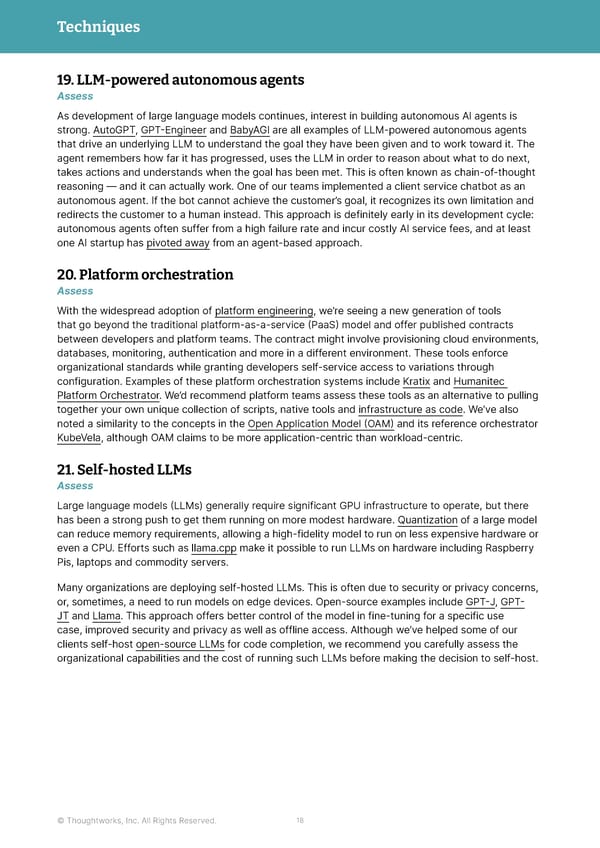Techniques 19. LLM-powered autonomous agents Assess As development of large language models continues, interest in building autonomous AI agents is strong. AutoGPT, GPT-Engineer and BabyAGI are all examples of LLM-powered autonomous agents that drive an underlying LLM to understand the goal they have been given and to work toward it. The agent remembers how far it has progressed, uses the LLM in order to reason about what to do next, takes actions and understands when the goal has been met. This is often known as chain-of-thought reasoning — and it can actually work. One of our teams implemented a client service chatbot as an autonomous agent. If the bot cannot achieve the customer’s goal, it recognizes its own limitation and redirects the customer to a human instead. This approach is definitely early in its development cycle: autonomous agents often suffer from a high failure rate and incur costly AI service fees, and at least one AI startup has pivoted away from an agent-based approach. 20. Platform orchestration Assess With the widespread adoption of platform engineering, we’re seeing a new generation of tools that go beyond the traditional platform-as-a-service (PaaS) model and offer published contracts between developers and platform teams. The contract might involve provisioning cloud environments, databases, monitoring, authentication and more in a different environment. These tools enforce organizational standards while granting developers self-service access to variations through configuration. Examples of these platform orchestration systems include Kratix and Humanitec Platform Orchestrator. We’d recommend platform teams assess these tools as an alternative to pulling together your own unique collection of scripts, native tools and infrastructure as code. We’ve also noted a similarity to the concepts in the Open Application Model (OAM) and its reference orchestrator KubeVela, although OAM claims to be more application-centric than workload-centric. 21. Self-hosted LLMs Assess Large language models (LLMs) generally require significant GPU infrastructure to operate, but there has been a strong push to get them running on more modest hardware. Quantization of a large model can reduce memory requirements, allowing a high-fidelity model to run on less expensive hardware or even a CPU. Efforts such as llama.cpp make it possible to run LLMs on hardware including Raspberry Pis, laptops and commodity servers. Many organizations are deploying self-hosted LLMs. This is often due to security or privacy concerns, or, sometimes, a need to run models on edge devices. Open-source examples include GPT-J, GPT- JT and Llama. This approach offers better control of the model in fine-tuning for a specific use case, improved security and privacy as well as offline access. Although we’ve helped some of our clients self-host open-source LLMs for code completion, we recommend you carefully assess the organizational capabilities and the cost of running such LLMs before making the decision to self-host. © Thoughtworks, Inc. All Rights Reserved. 18
 Thoughtworks Technology Radar Page 17 Page 19
Thoughtworks Technology Radar Page 17 Page 19